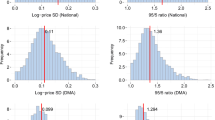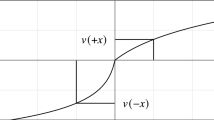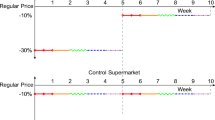Abstract
Recent theoretical research on retail pricing dynamics provides an explanation of why retailers periodically put items on sale, even when their costs are unchanged. The authors extend this research to show that more popular items (i.e., those that appeal to a wide range of consumers) are more likely to go on sale. One implication of the proposed model is that a good is more likely to be on sale when demand for the good is at its season peak (e.g., eggs at Easter). This implication is tested using store-level retail price data, and the prediction is borne out for the categories of goods that are examined. Additional tests also support the premise that popularity and frequency of sales are positively related.
Similar content being viewed by others
REFERENCES
Banks, J., & Moorthy, S. (1999). A model of price promotions with consumer search. International Journal of Industrial Organization, 17, 371–398.
Bliss, C. (1988). A theory of retail pricing. Journal of Industrial Economics, 36, 375–391.
Chevalier, J., Kashyap, A., & Rossi, P. (2000). Why don't prices rise during periods of peak demand? Evidence from scanner data. Cambridge, MA: National Bureau of Economic Research. NBER Working Paper 7981.
Conlisk, J., Gerstner, E., & Sobel, J. (1984). Cyclic pricing by a durable goods monopolist. Quarterly Journal of Economics, 99, 489–505.
Hosken, D., Matsa, D., & Reiffen, D. (2001). Pricing dynamics of multiproduct retailers. Advances in Applied Microeconomics, 10, 129–154.
Hosken, D., & Reiffen, D. (2001). Multiproduct retailers and the sale phenomenon. Agribusiness, 17, 115–137.
Hosken, D., & Reiffen, D. (in press). Patterns of retail price variation. Rand Journal of Economics.
Lal, R., & Matutes, C. (1989). Price competition in multimarket duopolies. Rand Journal of Economics, 20, 516–537.
Lal, R., & Matutes, C. (1994). Retail pricing and advertising strategies. Journal of Business, 67, 345–370.
Levy, D., Bergen, M., Dutta, S., & Venable, R. (1997). The magnitude of menu costs: Direct evidence from large U.S. supermarket chains. Quarterly Journal of Economics, 112, 791–825.
MacDonald, J. (2000). Demand, information, and competition: Why do food prices fall at seasonal demand peaks? Journal of Industrial Economics, 48, 27–45.
Moulton, B. (1990). An illustration of a pitfall in estimating the effects of aggre-gate variables on micro units. Review of Economics and Statistics, 72, 334–338.
Pashigian, B. P. (1988). Demand uncertainty and sales: A study of fashion and mark-down pricing. American Economic Review, 78, 936–853.
Pashigian, B. P., & Bowen, B. (1991). Why are products sold on sales? Explanations of pricing regularities. Quarterly Journal of Economics, 106, 1014–1038.
Pesendorfer, M. (2002). Retail sales: A study of pricing behavior in supermarkets. Journal of Business, 75, 33–66.
Sobel, J. (1984). The timing of sales. Review of Economic Studies, 51, 353–368.
Steiner, R. (1973). Does advertising lower consumer prices? Journal of Marketing, 37(4), 19–26.
Varian, H. R. (1980). A model of sales. American Economic Review, 70, 651–659.
Warner, E. J., & Barsky, R. B. (1995). The timing and magnitude of retail store markdowns: Evidence from weekends and holidays. Quarterly Journal of Economics, 110, 321–352.
Author information
Authors and Affiliations
Rights and permissions
About this article
Cite this article
Hosken, D., Reiffen, D. How Retailers Determine Which Products Should Go on Sale: Evidence From Store-Level Data. Journal of Consumer Policy 27, 141–177 (2004). https://doi.org/10.1023/B:COPO.0000028171.70221.f3
Issue Date:
DOI: https://doi.org/10.1023/B:COPO.0000028171.70221.f3




